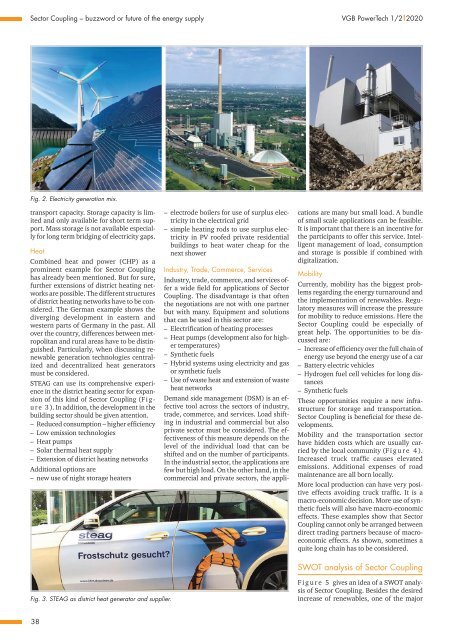VGB POWERTECH Issue 1/2 (2020)
VGB PowerTech - International Journal for Generation and Storage of Electricity and Heat. Issue 1/2 (2020). Technical Journal of the VGB PowerTech Association. Energy is us! Sector coupling. RWE Project ALIGN-CCUS. Passive acoustic imaging in power plants.
VGB PowerTech - International Journal for Generation and Storage of Electricity and Heat. Issue 1/2 (2020).
Technical Journal of the VGB PowerTech Association. Energy is us!
Sector coupling. RWE Project ALIGN-CCUS. Passive acoustic imaging in power plants.
Erfolgreiche ePaper selbst erstellen
Machen Sie aus Ihren PDF Publikationen ein blätterbares Flipbook mit unserer einzigartigen Google optimierten e-Paper Software.
Sector Coupling – buzzword or future of the energy supply <strong>VGB</strong> PowerTech 1/2 l <strong>2020</strong><br />
Fig. 2. Electricity generation mix.<br />
transport capacity. Storage capacity is limited<br />
and only available for short term support.<br />
Mass storage is not available especially<br />
for long term bridging of electricity gaps.<br />
Heat<br />
Combined heat and power (CHP) as a<br />
prominent example for Sector Coupling<br />
has already been mentioned. But for sure,<br />
further extensions of district heating networks<br />
are possible. The different structures<br />
of district heating networks have to be considered.<br />
The German example shows the<br />
diverging development in eastern and<br />
western parts of Germany in the past. All<br />
over the country, differences between metropolitan<br />
and rural areas have to be distinguished.<br />
Particularly, when discussing renewable<br />
generation technologies centralized<br />
and decentralized heat generators<br />
must be considered.<br />
STEAG can use its comprehensive experience<br />
in the district heating sector for expansion<br />
of this kind of Sector Coupling (F i g -<br />
u r e 3 ). In addition, the development in the<br />
building sector should be given attention.<br />
––<br />
Reduced consumption – higher efficiency<br />
––<br />
Low emission technologies<br />
––<br />
Heat pumps<br />
––<br />
Solar thermal heat supply<br />
––<br />
Extension of district heating networks<br />
Additional options are<br />
––<br />
new use of night storage heaters<br />
––<br />
electrode boilers for use of surplus electricity<br />
in the electrical grid<br />
––<br />
simple heating rods to use surplus electricity<br />
in PV roofed private residential<br />
buildings to heat water cheap for the<br />
next shower<br />
Industry, Trade, Commerce, Services<br />
Industry, trade, commerce, and services offer<br />
a wide field for applications of Sector<br />
Coupling. The disadvantage is that often<br />
the negotiations are not with one partner<br />
but with many. Equipment and solutions<br />
that can be used in this sector are:<br />
––<br />
Electrification of heating processes<br />
––<br />
Heat pumps (development also for higher<br />
temperatures)<br />
––<br />
Synthetic fuels<br />
––<br />
Hybrid systems using electricity and gas<br />
or synthetic fuels<br />
––<br />
Use of waste heat and extension of waste<br />
heat networks<br />
Demand side management (DSM) is an effective<br />
tool across the sectors of industry,<br />
trade, commerce, and services. Load shifting<br />
in industrial and commercial but also<br />
private sector must be considered. The effectiveness<br />
of this measure depends on the<br />
level of the individual load that can be<br />
shifted and on the number of participants.<br />
In the industrial sector, the applications are<br />
few but high load. On the other hand, in the<br />
commercial and private sectors, the applications<br />
are many but small load. A bundle<br />
of small scale applications can be feasible.<br />
It is important that there is an incentive for<br />
the participants to offer this service. Intelligent<br />
management of load, consumption<br />
and storage is possible if combined with<br />
digitalization.<br />
Mobility<br />
Currently, mobility has the biggest problems<br />
regarding the energy turnaround and<br />
the implementation of renewables. Regulatory<br />
measures will increase the pressure<br />
for mobility to reduce emissions. Here the<br />
Sector Coupling could be especially of<br />
great help. The opportunities to be discussed<br />
are:<br />
––<br />
Increase of efficiency over the full chain of<br />
energy use beyond the energy use of a car<br />
––<br />
Battery electric vehicles<br />
––<br />
Hydrogen fuel cell vehicles for long distances<br />
––<br />
Synthetic fuels<br />
These opportunities require a new infrastructure<br />
for storage and transportation.<br />
Sector Coupling is beneficial for these developments.<br />
Mobility and the transportation sector<br />
have hidden costs which are usually carried<br />
by the local community (F i g u r e 4 ).<br />
Increased truck traffic causes elevated<br />
emissions. Additional expenses of road<br />
maintenance are all born locally.<br />
More local production can have very positive<br />
effects avoiding truck traffic. It is a<br />
macro-economic decision. More use of synthetic<br />
fuels will also have macro-economic<br />
effects. These examples show that Sector<br />
Coupling cannot only be arranged between<br />
direct trading partners because of macroeconomic<br />
effects. As shown, sometimes a<br />
quite long chain has to be considered.<br />
SWOT analysis of Sector Coupling<br />
Fig. 3. STEAG as district heat generator and supplier.<br />
F i g u r e 5 gives an idea of a SWOT analysis<br />
of Sector Coupling. Besides the desired<br />
increase of renewables, one of the major<br />
38


















